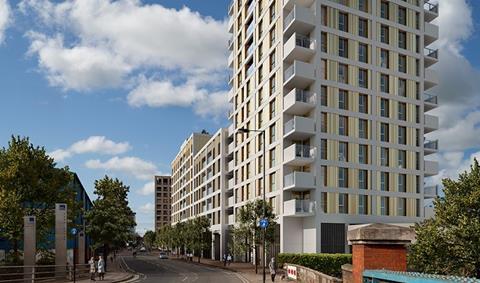Three major residential developments in Old Oak Common have received the green light, kick-starting construction at London’s biggest opportunity area and the UK’s largest regeneration scheme, the only point in the UK where HS2 and Crossrail will meet.

The significance of these consents on Scrubs Lane should not be underestimated. The landmark buildings, ranging from 6 to 22 storeys, will stimulate further investment in the opportunity area, delivering much-needed housing in the capital.
However, the design and height of these schemes were not conceived at the outset. With the sites located next door to heritage assets (the Grade I registered Kensal Green Cemetery and the Grand Union Canal), the OPDC showed initial hesitancy to build high, with a focus on sensitive edges rather than the opportunity for tall buildings to improve the surrounding area and increase housing stock.
Two years later, three consents for an ambitious vision of the area have been achieved – daring to go tall near these heritage assets proves that we must now look at housing development in the capital through a different lens.
We need to test more closely areas that are traditionally seen as unable or less able to absorb the impact of tall buildings.

If necessary, we should revisit policy. If a particular building proposal is not out of place, delivers key design measures and can contribute to an acute housing shortfall, then its appropriateness should be evaluated in an open-minded and forward-thinking way.
Setting sights ambitiously high
For inspiration, we need look no further than Manchester, a city flourishing amid strong housing demand and significant development activity.
Manchester is the UK’s fastest growing metropolis. It is showing London how the development of quality housing in high buildings does not have to be a tall order. The sheer volume of upwards development is staggering, with some analysts predicting that there could be 25 towers over 100 metres in Greater Manchester over the next decade.
Rather than starting from a position of caution, Manchester has set its sights ambitiously high, focusing on top-quality design and delivery to harness the opportunity that taller buildings present for improving surrounding areas rather than considering the impact on heritage assets in isolation.
Manchester’s Angel Meadow development is a perfect example of this. It spans four sites surrounding the edges of the historically significant Angel Meadow Park. Despite its location, a 40-storey tower will sit proudly at the top of the park.
There is clearly a lesson to be learned from this northern powerhouse. To meet housing demand, London needs to test more carefully the impact on heritage assets and the potential public benefits of well-designed tall buildings. We need to ensure that London’s housing delivery is supercharged and not a tall order.






























No comments yet